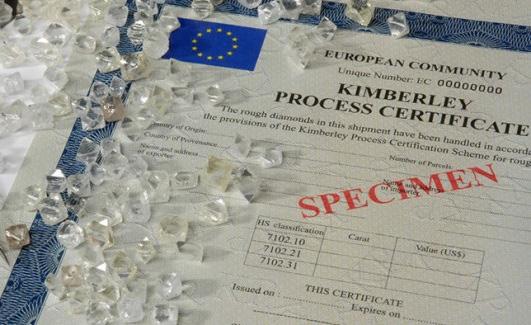
3 minute read
Contradictions of the ‘blood diamonds’ governance mechanism
THE Kimberley Process (KP) is the international governance mechanism for the global diamond production market. Yet, the effectiveness of the KP has been challenged by reports of human rights violations in the Chiadzwa-Marange diamond fields in Zimbabwe.
The country expects to increase production from 3.2 million carats in 2022 to 11 million this year. But at what cost?
Advertisement
In 2021, the total global production volume of rough diamonds stood at approximately 120 million carats –representing $13.99 billion in production value declared by diamond-exporting countries. Most rough diamonds are used for industrial purposes (46 per cent), while a smaller proportion (19 per cent) is produced into high-quality, polished stones. The figures quoted here only cover “legitimate” diamond-mining activities.
In the late 1990s, diamonds were used to finance the activities of rebel movements in Liberia, Sierra Leone, the Democratic Republic of Congo and Angola. The international NGO campaign against “blood diamonds” placed pressure on the diamond industry to take action and cease buying stones from illicit channels.
These events set in motion what became known as the KP, a series of inter-governmental meetings led by three African diamond-exporting governments, South Africa, Botswana and Namibia, that set out, through a multilateral endeavour, to stop the trade in conflict diamonds.
The internationally binding Kimberley Process Certification Scheme (KPCS) maps the origins of rough diamonds implemented through a set of trade mechanisms aimed at preventing conflict diamonds from entering the legitimate global market. It increased legalisation and transparency in diamond production.
The KP has been incredibly effective in preventing conflict diamonds from entering the international supply chain. Key actors in the establishment of the KP laud its successes. For instance, diamond magnate Nicky Oppenheimer estimates that 99 per cent of world diamond production is “conflict-free”.
Yet, two decades on, the shortfalls of the KP defines these as “rough diamonds used by rebel movements or their allies to finance conflict aimed at undermining legitimate governments”.
The KP overlooks violence that is embedded in the regulatory interventions of some governments, such as the forceful eviction of local populations and artisanal miners from diamond fields. The narrow “conflict diamond” definition does not confront repressive regimes or combat human rights abuses. Nor does it recognise environmental pollution and degradation, and the conflicts that arise out of the dispossession of communities through the the KP have become increasingly visible. These are related to how the KP defines conflict diamonds. The Core Document of loss of property, land and livelihoods.
These issues are especially relevant to the Chiadzwa-Marange alluvial diamond fields in Zimbabwe. In June 2006, massive deposits of alluvial diamonds were discovered in Marange, a very poor, rural area near Zimbabwe’s eastern border with Mozambique.
The diamond deposits in ChiadzwaMarange are found on or near the surface, span across a large area and they are easily mined. As “lootable” resources they have proven to be incredibly difficult to secure.
Following the discovery, there was an influx of thousands of informal miners, traders and dealers into the area – all desperate to escape extreme poverty and deprivation. In 2008, President Robert Mugabe's party, the Zimbabwean African National Union-Patriotic Front (ZANU-PF), deployed the military to the fields through Operation Hakudzokwi Kumunda, which translates to: “You will not come back from the fields alive.”
The military operation resulted in the killing of about 200 miners in the space of five weeks. In the years that followed, soldiers and police officers developed pathways for the illicit smuggling of diamonds to external traders, and the securitisation of the fields came to be “associated with significant loss of life and human rights abuses, including torture, rape, beatings, abduction, irregular detention and imprisonment”.
Following civil society action, the KPCS Review Mission of Zimbabwe was initialised in mid-2009, following which the KP plenary suspended diamond exports from Marange. After a three-year review process, the appointed Kimberley monitor, Abbey Chikane from South Africa, declared that the mines met the KPCS criteria.
In March 2011, the sale of ChiadzwaMarange diamonds was approved by the KP despite objections from civil society that they did not meet KPCS standards, and that dubious deals and human rights abuses were still rampant.
As the KP failed to entrench an expanded definition of “conflict diamonds” to include a human rights-based framework, it also failed in its nominal commitment to ensure that diamonds contribute toward Zimbabwe's development – with up to $15 billion in diamond revenue alleged to have disappeared without trace into the international informal markets.
The “formalisation” of the ChiadzwaMarange field has not transformed the economy and living standards of the community, nor Zimbabweans more broadly, in any significant way.
The KP, as an African-led process, made major inroads in uniting disparate groups (civil society, governments and the diamond industry) around a common cause: the need to starve insurgent groups from diamond revenues used to fund conflict.
Nevertheless, the KP has yet to develop an expanded definition of conflict diamonds. This puts many local, artisanal mining communities at risk of state repression, such as in Zimbabwe. And so, the question becomes: why are the Zimbabwean diamonds on the international market not considered “blood diamonds”?










